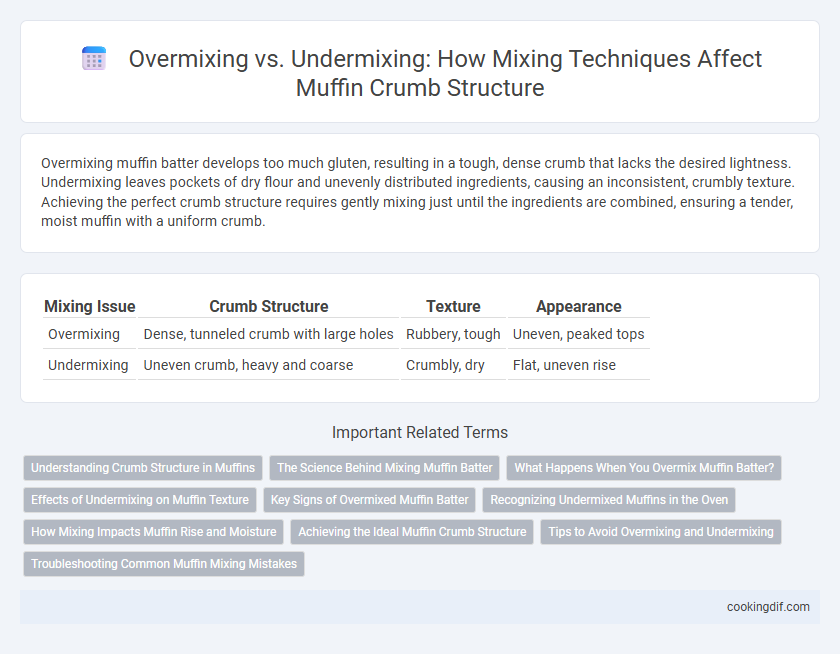Overmixing muffin batter develops too much gluten, resulting in a tough, dense crumb that lacks the desired lightness. Undermixing leaves pockets of dry flour and unevenly distributed ingredients, causing an inconsistent, crumbly texture. Achieving the perfect crumb structure requires gently mixing just until the ingredients are combined, ensuring a tender, moist muffin with a uniform crumb.
Table of Comparison
| Mixing Issue | Crumb Structure | Texture | Appearance |
|---|---|---|---|
| Overmixing | Dense, tunneled crumb with large holes | Rubbery, tough | Uneven, peaked tops |
| Undermixing | Uneven crumb, heavy and coarse | Crumbly, dry | Flat, uneven rise |
Understanding Crumb Structure in Muffins
Proper mixing directly influences muffin crumb structure by balancing gluten development and air incorporation. Overmixing generates a tough, dense crumb due to excessive gluten formation, while undermixing results in an uneven crumb with tunnels and dense pockets caused by inadequate ingredient integration. Achieving an optimal muffin crumb requires mixing the batter just until the dry and wet ingredients combine, preserving a tender, moist texture with a uniform crumb.
The Science Behind Mixing Muffin Batter
The crumb structure of muffins is directly influenced by the mixing process, where overmixing causes excessive gluten development, resulting in a tough and dense texture. Undermixing leaves pockets of dry flour, leading to uneven crumb and inconsistent rise. Properly mixed batter balances gluten formation and aeration, producing a tender, moist crumb with uniform air pockets essential for optimal muffin texture.
What Happens When You Overmix Muffin Batter?
Overmixing muffin batter causes the gluten strands to develop excessively, resulting in a dense, tough crumb rather than a light, tender texture. This excessive mixing traps air and creates tunnels or large holes within the crumb, compromising its uniformity and moistness. Proper mixing ensures a balanced crumb structure with a soft, moist texture and consistent rise.
Effects of Undermixing on Muffin Texture
Undermixing muffin batter results in unevenly distributed ingredients, causing a dense crumb with large air pockets and a coarse texture. This weak gluten development leads to crumbly muffins that lack structural integrity and have inconsistent rise. Maintaining minimal but sufficient mixing ensures a tender, moist crumb and even crumb structure in muffins.
Key Signs of Overmixed Muffin Batter
Key signs of overmixed muffin batter include a dense, tough crumb and a peaked or domed top instead of a tender, moist texture. Overmixing develops excessive gluten, causing the batter to become gummy and resulting in tunnels or holes within the muffin. Identifying these signs early helps achieve a light, fluffy muffin crumb by mixing just until combined.
Recognizing Undermixed Muffins in the Oven
Undermixed muffins often have a dense, uneven crumb structure with large, irregular air pockets due to insufficient gluten development and incomplete ingredient incorporation. Recognizing undermixed muffins in the oven involves observing a lumpy batter surface and uneven rising, where the tops may be flatter and the interior appears gummy or heavy once baked. Proper mixing ensures a uniform crumb with consistent texture and optimal moisture distribution.
How Mixing Impacts Muffin Rise and Moisture
Overmixing muffin batter causes excessive gluten development, resulting in a dense, tough crumb with reduced rise and dryness. Undermixing leaves flour pockets and uneven ingredient distribution, leading to an irregular crumb texture and insufficient rise. Proper mixing balances gluten formation and aeration, ensuring optimal muffin moisture, uniform crumb, and a tender, fluffy rise.
Achieving the Ideal Muffin Crumb Structure
Achieving the ideal muffin crumb structure relies on balancing mixing techniques to avoid overmixing, which develops excess gluten resulting in a tough, dense crumb, and undermixing, which leads to irregular pockets of flour and uneven texture. Proper mixing creates a tender crumb with uniform air pockets, essential for a soft and moist muffin. Techniques such as folding wet and dry ingredients gently until just combined preserve the delicate crumb while ensuring consistent leavening.
Tips to Avoid Overmixing and Undermixing
To achieve the ideal crumb structure in muffins, mix the batter just until the dry ingredients are incorporated, avoiding overmixing that causes dense, tough muffins with tunnels. Use gentle folding techniques with a rubber spatula and stop mixing as soon as no streaks of flour remain to prevent undermixing, which results in uneven crumb and pockets of raw flour. Monitoring batter consistency and aiming for a lumpy texture ensures a tender and moist crumb.
Troubleshooting Common Muffin Mixing Mistakes
Overmixing muffin batter leads to a tough, dense crumb due to gluten overdevelopment, while undermixing results in uneven texture with pockets of dry flour. Identifying the ideal balance during mixing avoids tunneling and dry spots, promoting a tender and moist crumb structure. Using a gentle folding technique until just combined ensures consistent crumb quality and optimal muffin rise.
Overmixing vs Undermixing for crumb structure Infographic

 cookingdif.com
cookingdif.com